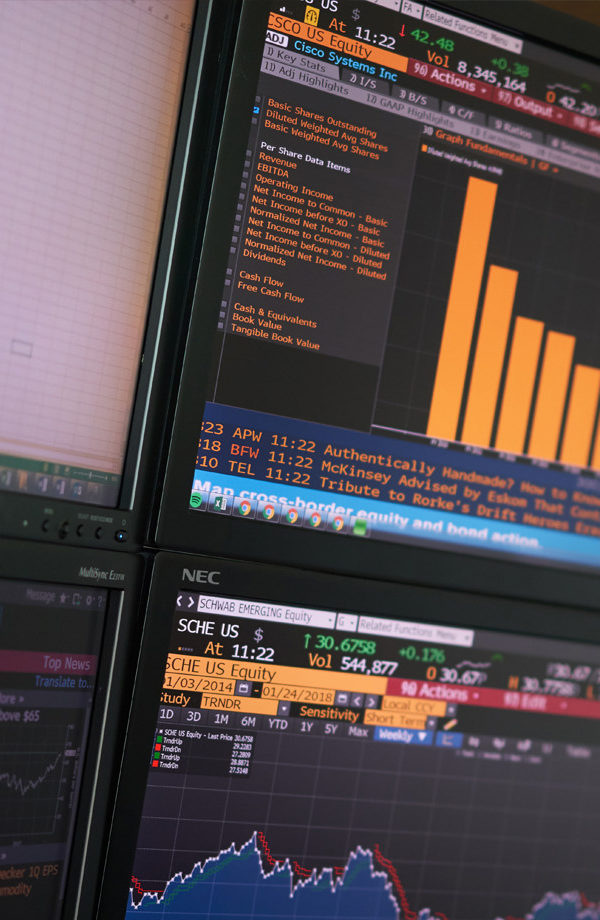Ackerman ResourcesACM Market Commentary & “Our Best Calls”
The science of investing combined with decades of investment experience
Our quantitative investment models are informed by our macro-views of the economy and the capital markets. We have the experience and confidence to make independent assessments of the investment landscape, even when they run contrary to popular views. Over many decades, often during times of heightened levels of investor greed or fear, we have stood apart from the crowd with our thoughtful and astute forecasts. Below are chronological excerpts from ACM commentaries that represent some of our most important market calls.
ACM Value & Trend Report – Most Recent Quarter
ACM Market Commentary
ACM Wealth Management & Other Topical Posts
Structuring and Funding of Special Needs Plans
Beginning of Year Financial Planning Goals: Setting Yourself Up for a Successful Year
As the new year rolls in, it’s the perfect time to reflect on your financial goals and set a solid plan in motion. The beginning of the year is a time of fresh starts, and that includes your finances. By establishing clear financial planning goals, you can set yourself up for a successful year, paving the way for a healthier financial future....
Questions to ask yourself when checking in on your finances
Happy New Year! Here’s to the Next 1000 Days
Ackerman Capital Management and Keith Pillers Named “Best in D”
Wealth Transfer Planning – Family Trusts and Family Limited Partnerships
Charitable Planning – Cash Donations
Let’s Review Your IRA Beneficiary Designations
PROVIDE YOUR EMAIL TO AUTOMATICALLY RECEIVE THE NEXT ACM QUARTERLY MARKET COMMENTARY AS IT BECOMES AVAILABLE
“Our Best Calls” – Excerpts from ACM commentaries & market insights
ACM Predicts 2000 Technology & Internet Stocks Crash
“…we are long overdue for disappointment. And when it comes, it will probably be a big disappointment. Stock valuations in general are at an all-time high, despite rising interest rates…The valuations of many of the technology and internet-related stocks…are so ridiculously extended that extreme price declines are inevitable and imminent.”
— David Ackerman, IdeaAdvisor.com, April, 10, 2000
“…the speculative bubble in technology stocks has reached its final stage…Investors are now focusing on only the highest risk situations. This is indicative of a peak in speculative enthusiasm and portends that the end of the technology and Internet stock bubble is near.”
— ACM Quarterly Commentary, April 20, 2000
“We have now entered a period where ‘old-school’ notions of investing should be followed. One of those unfashionable concepts is that corporate profits matter, and that over time a company’s stock price should roughly track a company’s growth in profits. Therefore, the stocks of cash-burning ‘dot com’ and biotechnology companies should be shunned to avoid further losses.”
— ACM Quarterly Commentary, July 20, 2000
TECHNOLOGY AND INTERNET STOCKS CRASHED IN THE FOLLOWING TWO YEARS. THE NASDAQ COMPOSITE FELL 74.9% FROM THE MARCH 2000 HIGHS TO THE OCTOBER 2002 LOWS. THE INTERACTIVE WEEK INTERNET INDEX FELL 90.2% DURING THIS PERIOD.
ACM Navigates 9/11 Volatility & Continuation of Bear Market
“After the disastrous events of September 11, we were correct in our assessment that stocks were deeply oversold, generally undervalued, and that the widespread fear and bearish sentiment presented an attractive buying opportunity. So while many investors were selling stocks and stock mutual funds at a record pace, we were…increasing our stock exposure. Once, again we were rewarded by not ‘following the crowd’ … we are less excited about potential future stock returns after the strong fourth quarter rally. Stocks in general are now overvalued, while investor sentiment has returned to bullish levels that have usually preceded intermediate-term declines…In fact, in recent weeks we have lowered our stock market exposure across all of our accounts…We would not be surprised to see the major market averages decline for a third year in a row.”
— ACM Quarterly Commentary, January 24, 2002
THE S&P500 RALLIED 19.3% FROM ITS SEPTEMBER LOWS THROUGH THE END OF 2001. HOWEVER, THE MARKET FELL FOR THE THIRD CONSECUTIVE YEAR IN 2002, LOSING 22.1% IN ONE OF THE WORST CALENDAR YEARS FOR STOCK INVESTORS IN MODERN MARKET HISTORY.
ACM Calls Bottom of 2000-2002 Bear Market
“…the current level of the stock market represents an attractive investment opportunity…in relation to short-term interest rates, these prices represent the most attractive values investors have seen since the early 1980’s”
— ACM Quarterly Commentary, October 22, 2002
THE S&P 500 RECORDED ITS BEAR MARKET LOW THAT SAME MONTH AND WENT ON TO DELIVER A TOTAL RETURN OF MORE THAN 100% OVER THE NEXT FIVE YEARS.
ACM Predicts 2007-2008 Housing Collapse, Financial Crisis, & Recession
“While many economists and Wall Street strategists are predicting a “soft landing” for the economy, we are less optimistic. We have long believed that the housing boom was being driven to a much larger extent by aggressive lending practices than underlying fundamentals, and as a result, we believe that we are entering a housing slump that will be deeper and longer than most “experts” are predicting. Given that outlook and the integral part that housing activity plays in our economy, we believe that the risk of an eventual economic recession is fairly high.”
— ACM Quarterly Commentary, October 20, 2006
“The stock market is overdue for a correction. We suspect that this correction will materialize later this year as stocks discount lower corporate profits and an increasing risk of economic recession, precipitated in large part by a continue slide in housing activity”
— ACM Quarterly Commentary, January 15, 2007
“We continue to believe that the slowing residential housing market could likely push the economy into recession, and that eventually the stock market will discount this risk. Our focus, going forward, will soon shift towards reducing the risk in our portfolios given the looming correction in stock prices…The performance of the capital markets over the past four years has left many investors complacent about the possibility of losses. It is precisely when others are complacent that our contrarian approach leads us to be more aware of the risk to our portfolios.”
— ACM Quarterly Commentary, April 17, 2007
“…with investor sentiment reaching bullish extremes, we decisively reduced our equity allocation in late June of this year. Less than a month later, stock prices collapsed over liquidity concerns related to the mortgage markets and worsening data from the housing industry…We have used the recent rally to further reduce the equity exposure in our portfolios (relative to each portfolio’s target allocation). Despite the market rebound and some recent encouraging economic data, we continue to believe that an economic recession is inevitable given the weakness in the housing market.”
— ACM Quarterly Commentary, October 17, 2007
“Looking forward to this year, we believe that the stock market has not fully discounted the slowing economy. If we are not already in a recession, then we will likely be in one soon. Assuming this is the case stock could fall further…”
— ACM Quarterly Commentary, January 16, 2008
“While some may still debate the odds of a possible recession, we believe that is began last December or January. Furthermore, we believe that this recession could be deeper and last longer than many might expect. The housing downturn is far from over…As such we anticipate another down move in the markets before things improve. We can envision an eventual market bottom that will be accompanied by very negative investor sentiment in the face of scary headlines about regional bank failures as well as comparisons to the stagflation of the late 1970’s and even to the Great Depression.”
— ACM Quarterly Commentary, April 17, 2008
“We were not enticed by this recent stock market rally. We continue to believe that stock prices could fall further as they discount an economy that to us, at least, is clearly in recession….Looking forward, we expect to maintain a defensive posture in our portfolios until this market decline has run its course.”
— ACM Quarterly Commentary, July 15, 2008
THE FINANCIAL CRISIS OF 2007-2009 IS CONSIDERED TO HAVE BEEN THE WORST ECONOMIC CRISIS SINCE THE GREAT DEPRESSION OF THE 1930s. THE S&P 500 DECLINED NEARLY 43% FROM ITS OCTOBER 2007 HIGHS TO ITS MARCH 2009 LOWS. THE CRISIS WAS TRIGGERED BY A COLLAPSE IN THE SUBPRIME HOUSING MARKET WHICH PUSHED MAJOR U.S. FINANCIAL INSTITUTIONS AND THOSE AROUND THE WORLD TO THE BRINK OF COLLAPSE. GOVERNMENTS AND CENTRAL BANKS WERE FORCED TO BAIL OUT MANY OF THESE COMPANIES AND HAD TO RESPOND WITH UNPRECEDENTED MONETARY AND FISCAL STIMULUS. THE RECESSION WAS LATER DETERMINED TO HAVE BEGUN IN DECEMBER OF 2007.
ACM Pinpoints 2009 Bear Market Lows
“We added significant equity exposure at or near the exact market lows in March that preceded the current market rally. In most cases the amount of equity exposure added ranged from 10% to 15% and was concentrated in depressed value funds. Looking back many years from now, it will be clear that this period represented a good opportunity to buy stocks at attractive levels.”
— ACM Quarterly Commentary, April 23, 2009
THE STOCK MARKET LOW OCCURRED ON MARCH 9, 2009, COMMENCING A NINE-YEAR, 350% PLUS BULL MARKET IN THE S&P 500 INDEX.
ACM Navigates Volatile 2011 Stock & Bond Markets
“Generally speaking, the equity allocation in our portfolios are at or near the low end of investment policy ranges, and, conversely, our fixed income allocation are at or near the high end of their allocation ranges. In both asset classes our primary focus is “quality.”…We are avoiding exposure to commodities, commodity-oriented stocks, emerging market stocks and bonds…Today these investments are far too popular with the investment “crowd”…we believe these areas of the markets are vulnerable to significant price declines.”
– ACM Quarterly Commentary, May 12, 2011
“…we were in an excellent position to take advantage of lower prices. Across our portfolios, we took profits in our long and intermediate bonds and meaningfully increased our equity exposure at or near the market lows in August.”
– ACM Quarterly Commentary, October 27, 2011
“Given the relative magnitude of the summer stock correction and bond market rally, we responded by increasing stock market exposure significantly and moderating our quality bias within that exposure. Conversely, we lowered our bond market allocations and reduced the interest rate sensitivity of our remaining allocation. These moves allowed our portfolios to better participate in the strong stock market rally over the past six months.”
– ACM Quarterly Commentary, April 23, 2012
FROM JULY TO SEPTEMBER 2011, THE S&P 500 DECLINED 18%. MEANWHILE, MEASURED FROM PEAK TO TROUGH, THE BLOOMBERG COMMODITY INDEX FELL 22% AND EMERGING MARKET STOCKS DROPPED MORE THAN 40%. DURING THE SAME PERIOD, LONG-TERM U.S .TREASURY BONDS DELIVERED BETTER THAN 29%. SUBSEQUENTLY, THE S&P 500 BOTTOMED ON OCTOBER 3RD, 2011, RALLIED 15% THROUGH YEAR END, AND WENT ON TO GAIN 16% IN 2011.
ACM Navigates 2015-2016 Market Volatility
“In our portfolios, we have moved into a defensive position, with equity allocations about 10% below policy targets. The recent backup in interest rates has made bonds a bit more compelling versus equity markets that are showing some early signs of technical weakness. We believe that a modest correction is most likely and we would be buyers of stocks at lower prices or if they resume their uptrend. Within our equity portfolios, our valuation and trend models have kept us overweight U.S. stocks. From a style perspective, we continue to favor momentum and quality at the expense of our fundamental index fund with their value bent.”
— ACM Quarterly Commentary, August 10, 2015
“Amid all of this turmoil, we are pleased to report that our portfolios were more or less unscathed… Our proprietary quantitative models… led us to make few key decisions that enabled us to preserve our capital in these treacherous markets. (1) In May we reduced equity exposures to 10% below target allocations across our various risk offerings, and more or less, have remained there since; (2) Within our equity exposure, our portfolios were tilted toward the better performing U.S. Markets; (3) From an equity style perspective, we emphasized better-performing MOMENTUM and QUALITY (think growth stocks) all year; (4) A good portion of our non-U.S. stock exposure was hedged to the U.S. dollar; (5) We did not have any direct exposure to commodities or commodity-related stocks;…”
— ACM Quarterly Commentary, Feb. 9th, 2016
“The key development in the third quarter is that our trend models for stocks have turned positive for the first time since the spring of last year. As a result, we have been adding equity exposure across client portfolios at the expense of fixed income and alternative funds. Generally speaking, equity allocations in our portfolios are back to neutral policy targets for the first time in about fifteen months. A large portion of our equity additions was directed toward emerging market stocks, which continue to be the standout in our proprietary valuation/trend models.”
— ACM Quarterly Commentary, Oct. 28, 2016
“Looking forward, all signs seem to point to another positive year for the stock market. The economy is picking up momentum and market technicals are strong. Higher interest rates will eventually give the stock market some trouble, but not off of these extremely low levels. Politics aside, the Trump victory seems to have given the stock market a second wind and has increased the likelihood that this seven-year-old bull market could move into bubble territory.”
— ACM Quarterly Commentary, Feb. 7, 2017
GLOBAL STOCKS FELL MORE THAN 20% RELATIVE TO CORE U.S. BONDS FROM THEIR MAY 2015 HIGH TO THEIR FEBRUARY 2016 LOW (U.S. QUALITY AND MOMENTUM STOCKS DECLINED BY ONLY ABOUT HALF THAT AMOUNT). SUBSEQUENTLY, FROM THE END OF THE THIRD QUARTER 2016 AND THROUGH THE END OF 2017, GLOBAL STOCKS OUTPACED BONDS BY MORE THAN 25%.
ACM Navigates 2020 Covid-19 Market Volatility
“Today could well be the low of this correction, but in all likelihood, it will not be. That said, a smart, long-term investor who is looking to add to their stock holdings when prices fall, should not try to time the bottom perfectly to the day. The risk of missing it is just too high…Now is a buying opportunity, which is not to say there may be one or two more buying opportunities at lower prices in the weeks or months ahead. We encourage our clients to consider their financial and emotional risk tolerance…Some clients may want to consider adding available cash to their investment accounts to increase both their stocks and bond holdings…Other clients may want to consider changing their investment policy to target a higher equity percentage…Across all accounts we continue to buy stock funds in an effort to maintain equity allocations to target weights, now with an eye toward somewhat higher allocations…We fully understand your anxiety, fear, and perhaps panic. We encourage you not to derail your long-term investment objectives in an effort to ease your mind in the short-term. This is not the first time the financial markets have plummeted because of some new crisis that has arisen. Given time, they have always made their way back, ultimately rewarding investors who stayed the course.”
— ACM Client Memo, March 12, 2020
“Looking forward, we believe that the market low on March 23rd…was probably “the bottom” of this historic correction in stock prices. This view is based not only on the apparent peaking of the pandemic and plans for a gradual “reopening of the economy”, but on the character of the now 25% rally off the low. The magnitude and breadth of the recovery in stock prices, along with certain gauges of buying pressure, are consistent with other major market bottoms, as opposed to a “bear market rally”… we believe that stock prices will be higher a year from now, despite an uneven economic recovery, because of historically low interest rates… [the] spread of about 6% between projected stock and bond returns, also known as the “equity risk premium”, is the largest difference our models have indicated since the third quarter of 2011. When the equity risk premium is high, rising stock prices will attract even more capital as holders of cash and bonds tire of a paltry 1% return.
— ACM Quarterly Commentary, April 23, 2020
After the emergence of the coronavirus pandemic caused global stocks to fall more than 33% from mid-February to their low on March 23, they rallied nearly 50% over the next six months.
Please note – the above quotes are selected excerpts from ACM quarterly letters and published articles. These are not necessarily representative of all of the opinion pieces we have published. Full copies of the quoted materials can be provided upon request. As always, past performance does not guarantee future results.







